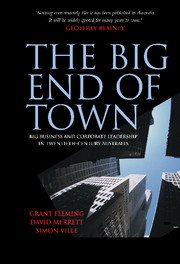Book contents
- Frontmatter
- Contents
- Preface
- 1 Introduction
- 2 The Development of Large-scale Enterprise in Australia
- 3 Identifying the Corporate Leaders
- 4 Paths of Corporate Development: Directions of Growth
- 5 Paths of Corporate Development: Methods of Growth
- 6 Financing Corporate Strategies
- 7 Organisational Configuration and Corporate Governance
- 8 Corporate Leaders, Big Business and the Economy
- Australian Standard Industrial Classification, 1969
- Abbreviations
- Appendix A
- Appendix B
- Notes
- Bibliography
- List of Tables and Figures
- Index
3 - Identifying the Corporate Leaders
Published online by Cambridge University Press: 22 September 2009
- Frontmatter
- Contents
- Preface
- 1 Introduction
- 2 The Development of Large-scale Enterprise in Australia
- 3 Identifying the Corporate Leaders
- 4 Paths of Corporate Development: Directions of Growth
- 5 Paths of Corporate Development: Methods of Growth
- 6 Financing Corporate Strategies
- 7 Organisational Configuration and Corporate Governance
- 8 Corporate Leaders, Big Business and the Economy
- Australian Standard Industrial Classification, 1969
- Abbreviations
- Appendix A
- Appendix B
- Notes
- Bibliography
- List of Tables and Figures
- Index
Summary
In Chapter 2 we used a range of time series and cross-sectional data on the economy and firms to present a broad picture of the growth of big business in the Australian economy, and drew parallels with the experience of other nations. We were able to identify in which sectors our largest firms have been located, how this changed over the course of the twentieth century, and who these firms were. This provides the basis for a closer investigation of some of these firms in this and subsequent chapters. Therefore, in this chapter, we will develop the concept of a corporate leader, a firm that is distinguished by more than just its size. We design a methodology for identifying corporate leaders in Australia, and then examine who these firms actually were. Reducing the number of firms analysed from 354 to around 78 enables us in chapters 4 to 7 to investigate more closely the pattern of their development using the methodological schema outlined in Chapter 1, notably the methods, resources, directions, and structure of development. From this, we seek to identify if any common patterns existed. In Chapter 8 we then assess what sort of role corporate leaders have played in the evolution of individual industries, the business sector, and the economy as a whole.
Prime movers and challengers
The notion of the first or prime mover examines the existence of firms that have played a dominant role in developing a new industry or transforming an existing one.
- Type
- Chapter
- Information
- The Big End of TownBig Business and Corporate Leadership in Twentieth-Century Australia, pp. 40 - 78Publisher: Cambridge University PressPrint publication year: 2004



